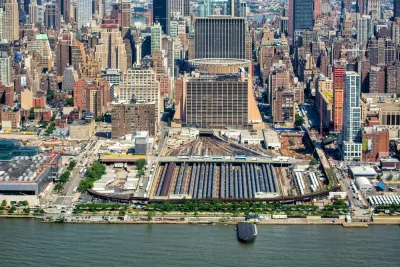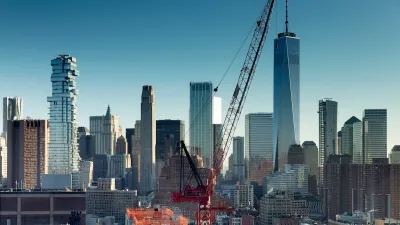In her article, "What Champions of Urban Density Get Wrong," the Philadelphia Inquirer's Inga Saffron critiques attempts to increase urban population. This post responds to her work.

Some prosperous American cities have a housing supply problem: they have made zoning more and more restrictive over time, thus causing limited housing supply, thus causing escalating housing prices. And because some people fleeing high housing prices move to automobile-dependent suburbs or smaller cities, restrictive urban zoning means more suburbanites with more cars, creating more pollution everywhere.
So one might think that the logical solution is to build more housing in urban areas, especially in the costliest markets. Yet in a recent article, the Philadelphia Inquirer's Inga Saffron wrote: "density has to be relative to what already exists … so neighborhoods can step up density gradually." In other words, don’t build too much stuff because…why? Most of her article seems devoted to the evils of tall buildings.
As far as I can tell, there are three myths underlying Saffron's article.
Myth 1: "Beware! The high-rises are coming!" Saffron writes that some unnamed "hard-line" density proponents "assume there is only one way to achieve real density. They use density as a rallying cry to justify the construction of more and bigger high-rises, in both America’s thriving cities and its hollowed-out ones."
This claim is a straw man; I don't know of anyone who thinks that the "only" way to create more density is high-rises. Even in dense places such as Manhattan or San Francisco, huge increases in density could occur without skyscrapers. For example, San Francisco has many one- and two-story buildings. If most of those buildings were replaced by four-story buildings, San Francisco could be two or three times as dense, and yet still have no high-rises.
If Saffron was really opposed only to tall buildings, she might argue that cities should seek dramatic increases in density and population by allowing more mid-sized buildings. But her suggestion that only "gradual" increases in density are appropriate implies that she would not like this idea either—so I actually don't understand what Saffron is trying to say. If she was just against high-rises, she'd be for large increases in density that didn't involve high-rises. But if she is against all significant increases in density, then why is she devoting so much space to attacking high-rises?
Myth 2: "If high-rises don’t solve everything, they don't solve anything." Saffron correctly points out that South Florida has plenty of high-rises but is not particularly walkable. But all this shows is that high-rises alone do not create walkability.
To be walkable, a neighborhood must have the "3 Ds": density, diversity (of land uses) and design (for pedestrians). There are parts of South Florida (most notably Miami Beach’s South Beach) where all these elements exist together.
But most of South Florida has at most one of these elements. In many areas, high-rises are only common within a few blocks of the water—so even dense high-rise blocks are islands of density in a low-density sea. Moreover, these high-rises are often separated by huge patches of parking or greenspace, thus reducing density. For example, go to Google Street View and look at 1340 A1A in Pompano Beach; you see will a few high and mid-rise buildings, but the blank spaces between the high-rises are one reason why the town only has 5080 people per square mile, far below the level generally necessary for good public transit service.
Moreover, Pompano Beach lacks diversity of land uses. The Walkscore of 1340 A1A is 28, indicating that there is almost nothing within walking distance of the high-rises.
Finally, a walkable area must be designed for pedestrians; streets must be narrow, and shops must be in front of the sidewalk rather than being set back behind a football field of parking. Much of South Florida, however, is dominated by multilane, high-speed stroads.
By contrast, a high-rise in a dense area designed around the pedestrian is likely to be pretty walkable. The buildings of Manhattan's Upper West Side are taller than those of Pompano Beach, yet more people get by without cars than in Pompano Beach. Why? Because the overall density of the neighborhood is much higher. Non-high-rise spaces are used for low-rise buildings rather than for parking. The Upper West Side is also designed for pedestrians as well; buildings are behind sidewalks rather than parking lots, and I suspect that on average streets are narrower than in Florida, although some are still too wide to be truly safe for pedestrians. Thus, the unwalkability of South Florida is not an argument against high-rises in San Francisco or New York.
In sum, high-rises are not sufficient for walkability. But that doesn't mean that they are incompatible with walkability. All else being equal, high-rises should add to walkability by adding density—but even if this is the case, building height is only one of several important factors.
Myth #3: "Cities don’t have the infrastructure for more people." Saffron writes that Hudson Yards (a new development in Midtown) is a failure* because "Midtown’s subway platforms and sidewalks are already oppressively crowded at rush hour." This argument, even if persuasive, is completely irrelevant to height: new residents might mean more crowded subways whether they live in rowhouses or whether they live in high-rises. So I'm not sure I understand Saffron: is she really just against height, or is she against density?
Let us assume for the sake of argument that Saffron is really against new urban residents, because new people mean more crowded subways and sidewalks. But this argument is essentially a "beggar thy neighbor" argument: if people are excluded from cities because of fears about traffic (pedestrian or otherwise), they will go somewhere else and create traffic. If they move to suburbs, they will buy cars and use those cars to create traffic jams in the suburbs—and in the cities too if they drive to urban jobs. And when they drive, they will create lots more pollution than if they were crowding the subways and sidewalks. Moreover, if the suburbs they move to are undeveloped, they will require costly, new infrastructure to service them, possibly imposing even higher costs on the public than new city residents.
*I note in passing that since Hudson Yards is so far west that it is (a) not very close to subways and (b) in the least crowded part of midtown Manhattan west of Ninth Avenue, Saffron's claim, even if true, doesn’t really seem relevant to Hudson Yards.

Americans May Be Stuck — But Why?
Americans are moving a lot less than they once did, and that is a problem. While Yoni Applebaum, in his highly-publicized article Stuck, gets the reasons badly wrong, it's still important to ask: why are we moving so much less than before?

Using Old Oil and Gas Wells for Green Energy Storage
Penn State researchers have found that repurposing abandoned oil and gas wells for geothermal-assisted compressed-air energy storage can boost efficiency, reduce environmental risks, and support clean energy and job transitions.

Placekeeping: Setting a New Precedent for City Planners
How a preservation-based approach to redevelopment and urban design can prevent displacement and honor legacy communities.

Study: Maui’s Plan to Convert Vacation Rentals to Long-Term Housing Could Cause Nearly $1 Billion Economic Loss
The plan would reduce visitor accommodation by 25,% resulting in 1,900 jobs lost.

Idaho Data: Unexpected Vehicle Repairs Exacerbate Housing Instability, Eviction Risk
Over 21 percent of clients struggle with transportation barriers.

A Year-Long Investigation On Permanent Supportive Housing
The New York Times reveals what’s working and what’s not in the cornerstone of Housing First.
Urban Design for Planners 1: Software Tools
This six-course series explores essential urban design concepts using open source software and equips planners with the tools they need to participate fully in the urban design process.
Planning for Universal Design
Learn the tools for implementing Universal Design in planning regulations.
Heyer Gruel & Associates PA
City of Moreno Valley
Institute for Housing and Urban Development Studies (IHS)
City of Grandview
Harvard GSD Executive Education
Salt Lake City
NYU Wagner Graduate School of Public Service
City of Cambridge, Maryland






























